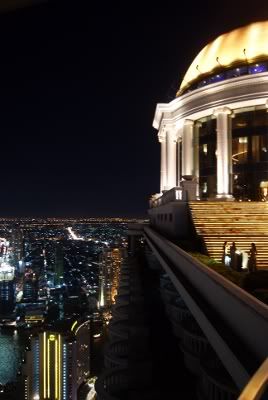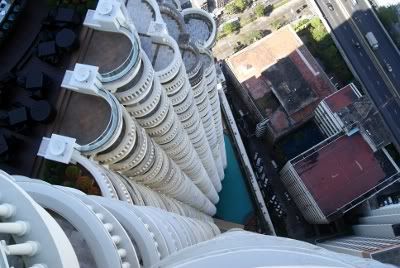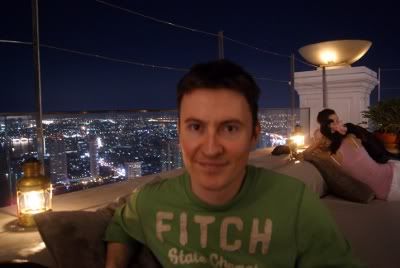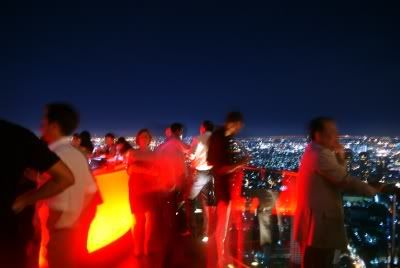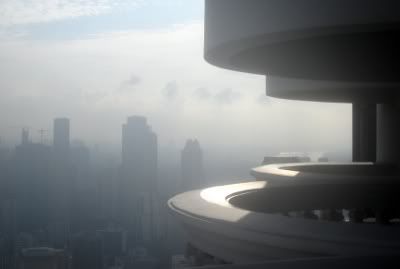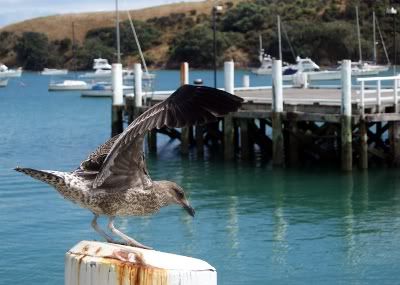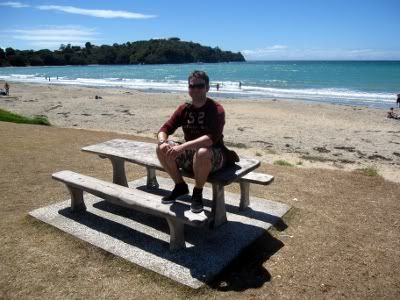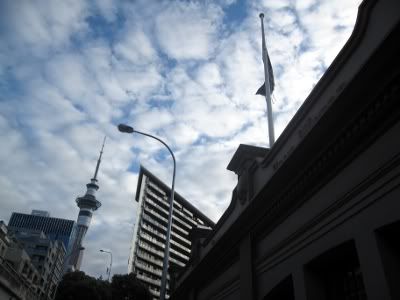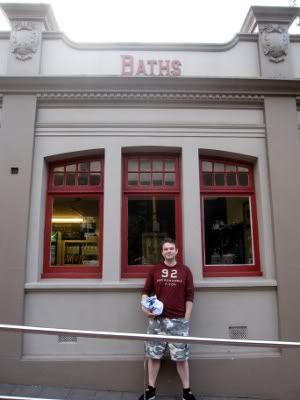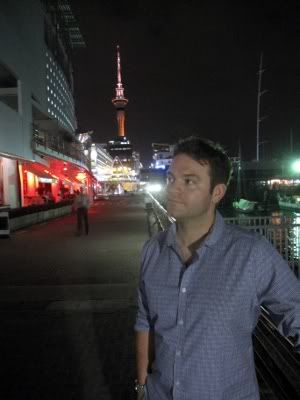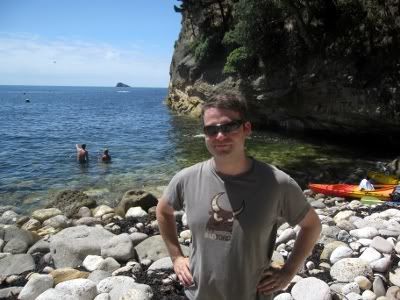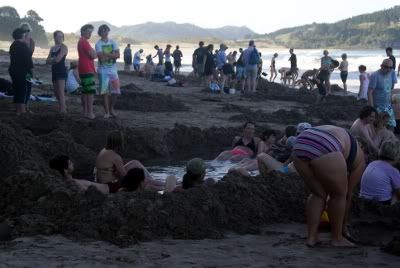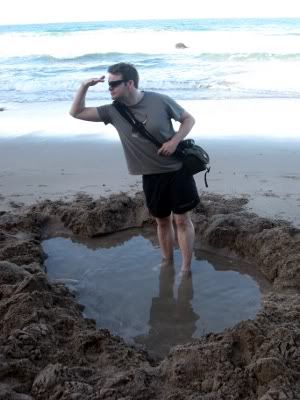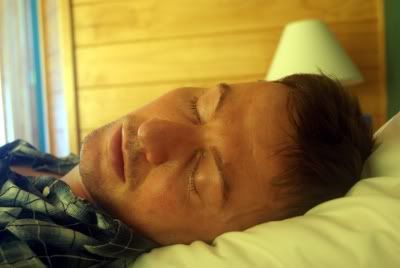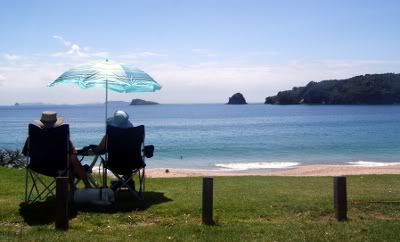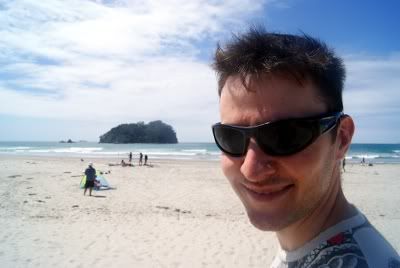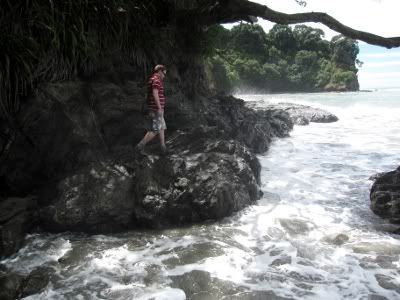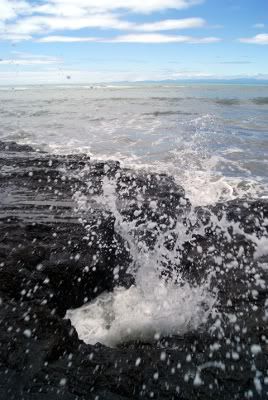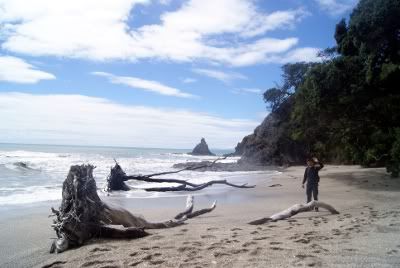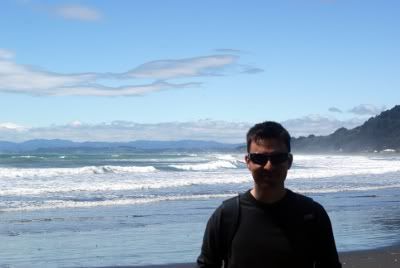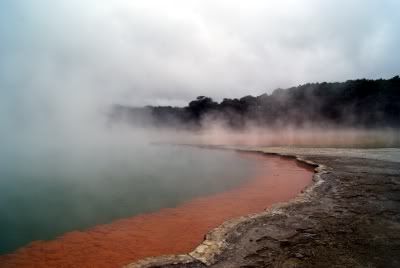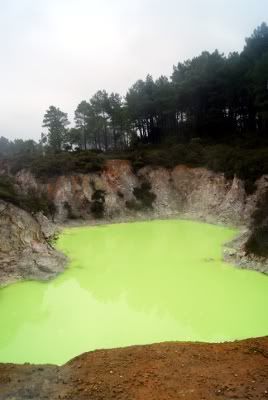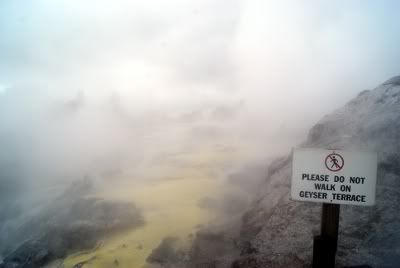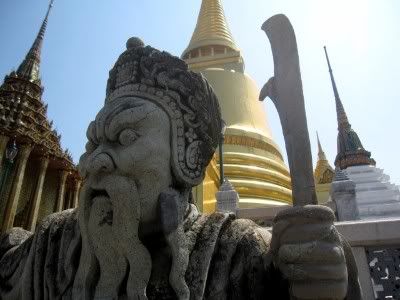
After
stuffing ourselves silly at the breakfast buffet to ensure we wouldn't need to eat again until the evening, we finally
waddled out of the hotel and into the streets of Bangkok proper. The difference was striking, not least as we accidentally went out through the back. Suddenly gone was the army of smiling Thai attendants in their smart white jackets who were paid to open doors, press lift buttons, carry bags and issue warnings as you approached steps, and in their place were
people crouched in the street eking out a living peeling potatoes, frying chicken or just sprawled on the pavement asleep. In the street directly behind our hotel each lamppost had a bird cage swinging on it, and the sky was virtually invisible behind a thick matting of overhead cables and wires. The tumbledown buildings were all no more than two or three storeys high, and it was rather sobering to realise these people were
literally living their lives in the shadow of our hotel.
As we walked through the streets towards the river,
legions of tuk-tuk drivers fought over themselves to attract our business, and they didn't seem to like taking no for an answer. Even when we could see our destination – the ferry pier outside the Oriental Hotel – tuk-tuk and taxi drivers were eager to drive us there.
We waved them away and struggled through the thirty feet trek on our own.
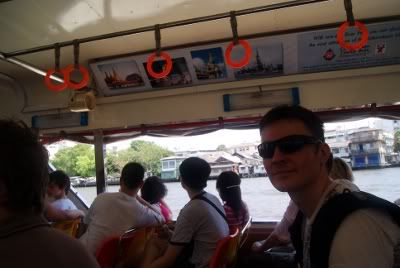
The
Express riverboats ploughing along the Chao Phraya river are the quickest and cheapest way of getting around the city,
costing just 25p each for the long journey up the river to the main attractions. Getting onto the right boat was more of a challenge however as we were
beleaguered by tricksters trying to persuade us to spend £10 on tourist boat cruises. Even as we walked down the pier we met official-looking locals who advised us there wouldn't be another Express riverboat for an hour and we were better off going with them. We had been prewarned however and waved them all away, and of course the riverboats turned out to be very frequent, offering
a somewhat scary Hop-On-Hop-Off Express service where the boat barely stopped at each pier for you to leap on before it powered off again up the river.
Our first destination was the Grand Palace, and we had been
warned by almost everyone who had even heard of Thailand that this was where we would come across the greatest concentration of conmen, whose apparent aim was to persuade you that the Grand Palace is shut and that you should take a tuk-tuk to their brother's gemstone shop instead. We
got past the first wave of attack quite successfully, only to almost fall to a very convincing young man who actually operated from the main gates of the Grand Palace itself – in full view of the guards – and carried a fairly convincing identity card. This man informed us that the palace was closed while the monks had their lunch (we later discovered there are no monks in the Grand Palace), and we were better off visiting some temple in the obscure northern suburbs for a couple of hours and coming back later,
and by the way here is a tuk-tuk we could use to get there, only thirty baht.
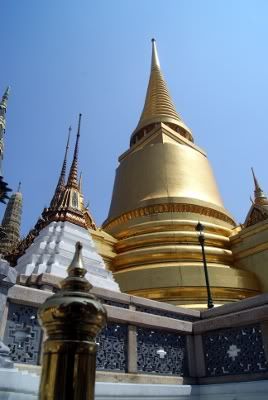
Well thankfully we'd been to Japan and had absolutely no interest in seeing any more temples than we absolutely had to (if anything, I felt that missing the Grand Palace might even be a blessing), and the moment he summoned a tuk-tuk
he stepped over the fine line between convincing facsimile of an official to blatant confidence trickster, so we effectively
told him to F the F Off and made our way into the Grand Palace despite his protestations. While I can appreciate Thailand is a very poor country and these people are only trying to eke out a living to support their families, I have been to much poorer countries in the past where locals support their families by offering goods and services the tourists actually want.
Conning tourists shows a remarkable lack of self-respect and a sad lack of national pride or interest in protecting the country's reputation. Most depressing of all is that it
appears to be state sponsored, to the extent that the guards of the Grand Palace were happy for the confidence tricksters to operate on and around their grounds, when it would be a small task to clear them away.
It would appear to be cheap to employ people in Thailand, as
employers will rarely hire one person for a job when the task can be divided down into four separate tasks for four different people. We hadn't realised one could not wear shorts in the Grand Palace and so had to queue to borrow some more discreet trousers. This required three men to tell us to get the trousers, a long queue to see a man to pay a deposit for the trousers, a queue to see two women who handed out the trousers, a queue to later return the trousers and a queue to then claim back your deposit at the end.
It felt like
a complete epic task just to get this far – and with the baking sun, humid atmosphere and polluted air I at times felt ready to just take the next taxi back to our hotel – but the moment
we stepped into the Grand Palace we were pleased to find it was all worth it. I didn't bother reading the guidebook to find out what the palace is, but effectively we found a large complex of incredibly detailed temples and other structures which appeared to have expanded over time on the site, from those built in simple carved stone, to those decorated intricately with coloured glass and ceramics, to
a single amazing gold-tiled prong which stood high above all else and glowed fabulously in the sunlight. All of the gaps between these structures were then filled with statues of lions, roosters, elephants, dragons,
dancing ladies, roaring giants and the type of ugly demon we saw lots of in Japan. 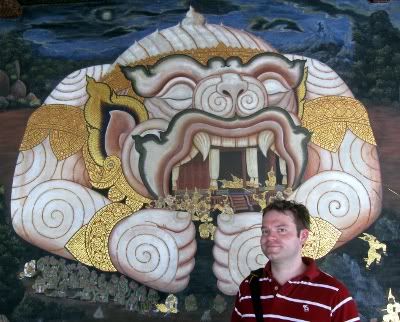
The main draw of the Grand Palace complex was supposed to be the Emerald Buddha, who lives in a huge temple at one end of the complex. We dutifully took off our shoes and trekked in to have a look and were confronted by
a huge pile of gaudy antiques with an absolutely miniature green statue balanced right at the top. There were almost as many 'No Photo' signs as there were religious artefacts, and during this holiday I've learned that the bigger tourist attractions are usually the ones less worth seeing so we nipped out and
enjoyed the superb lion statues instead.
Next on our itinerary was
the Reclining Buddha at Wat Po, and this time as conmen tried to distract us we simply smiled and waved at them as we strolled by, and so we arrived at the temple almost without incident. One particularly vocal man stood directly outside the temple and declared as we turned up “Hello! I am your guide for Wat Po!”. I don't think so, old man. “
It's a hundred foot golden Buddha”, we explained. “
We can probably find it ourselves.”
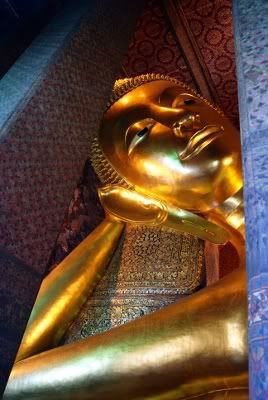
The Reclining Buddha is a 151 feet long statue coated in gold which – presumably due to the difficulty of building a 152 foot tall temple – is presented lying down on its side and gazing down serenely at the masses of people who stumble through the temple to peer at him. The huge pillars holding up the roof have been placed between the public area and the buddha itself, so as you stroll along the corridor
you can only see him in small cross sections: his face, his shoulders, his tummy button, his crotch, etc. It is also possible to stand at either end and see his full length, however thanks to perspective he then either
looks like he has a giant head or ridiculously long legs.
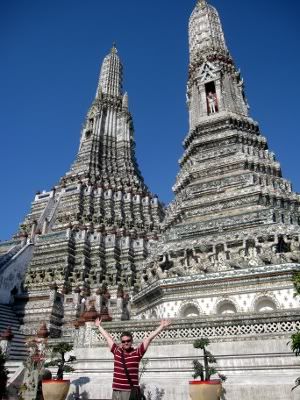
We raced back through the streets to catch a traghetti across the river to Wat Arun,
a somewhat home-made temple decorated with pieces of broken shell and porcelain which apparently came to the city as ballast in the boats from China, but which is quite beautiful for it and the recycled materials are quite brilliantly used. The temple is a very steep pyramid (or
mastaba, as archaeologists more accurately call it to anyone we think won't snigger) with
three viewing terraces at various levels, each reached by a stone staircase which is steeper than the last. This was my favourite of the temples we visited today, probably because it's the only one you can clamber over and explore and it's also a lot less gaudy than the others and you get a super view up at the top.
All this time the sun had been baking down and the air thick and humid, and standing there on the top of Wat Arun we were seized with an urgent desire to get back into our air conditioned hotel and drink water we knew was safe to drink.
We shoved our way down the three flights of steps, pushing the dawdling tourists out of the way, and stormed to catch the ferry home.
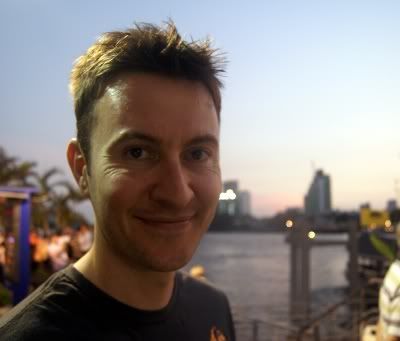
In the evening we took a
dinner cruise in an old rice barge along the Chao Phraya, which possibly
lost the element of surprise on account of us already having spent the day travelling along the river and seeing the same temples, but which nonetheless was a very
pleasant way to see the city all lit up at night. Somewhat less pleasant was the mass-produced Thai food we received, which had either gone cold or only been half-warmed through in the first place, and comprised some very dubious pieces of meat. On the return leg we were also treated to some traditional Thai dancing, which was all very sedate at first –
a lady bending her fingers back and hopping from foot to foot – and then a man dressed as a white lion entered the room and the performance suddenly became
a coordinated bitch fight.
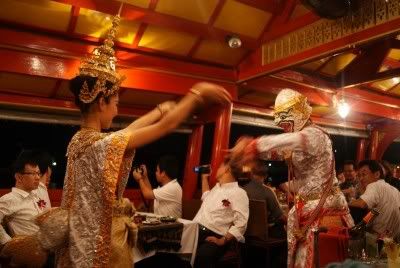
We considered going to the roof bar for one last nightcap, but we have an early start in the morning
and so to bed.











